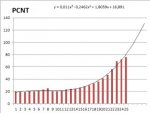Creating trendline of one individual over the population data.
Lets assume I have collected the data about how often people give a coin to beggar depending on the weather outside. So in Y-axis there is % from 0% to 100% and X-axis represents how good the weather is from min to max. I have divided weather from min-to max into 25 different stages and the result look like this
As you see when weather is bad then people mostly do not spare a penny but when weather goes fine then in the end almost 80% cases people give money when they are asked. This is collected over hundreds of thousands persons.
Now what I want to get is that I found one person - Jack Smith (JS) - about who I have information only that he has
- when weather was 5 then JS gave money 2 times of 8
- when weather was 11 then JS gave money 1 times of 1
- when weather was 15 then JS gave money 0 times of 1
- when weather was 17 then JS gave money 3 times of 5
- when weather was 18 then JS gave money 4 times of 5
- when weather was 22 then JS gave money 5 times of 8
As you see there is not much data about we can rely on but already we can see that Jack Smith is very kind person at least more that average population. Together with that information and knowing that also Jack Smith tends to be more gracious when weather wellness goes up then - can we create the "average trendline" for the Jack Smith also?
It doesn't have to be exact but close. For example JS trendline shape is sure close to the average population but how close - the less data we have then we have to assume that it is more close.
Lets assume I have collected the data about how often people give a coin to beggar depending on the weather outside. So in Y-axis there is % from 0% to 100% and X-axis represents how good the weather is from min to max. I have divided weather from min-to max into 25 different stages and the result look like this

As you see when weather is bad then people mostly do not spare a penny but when weather goes fine then in the end almost 80% cases people give money when they are asked. This is collected over hundreds of thousands persons.
Now what I want to get is that I found one person - Jack Smith (JS) - about who I have information only that he has
- when weather was 5 then JS gave money 2 times of 8
- when weather was 11 then JS gave money 1 times of 1
- when weather was 15 then JS gave money 0 times of 1
- when weather was 17 then JS gave money 3 times of 5
- when weather was 18 then JS gave money 4 times of 5
- when weather was 22 then JS gave money 5 times of 8
As you see there is not much data about we can rely on but already we can see that Jack Smith is very kind person at least more that average population. Together with that information and knowing that also Jack Smith tends to be more gracious when weather wellness goes up then - can we create the "average trendline" for the Jack Smith also?
It doesn't have to be exact but close. For example JS trendline shape is sure close to the average population but how close - the less data we have then we have to assume that it is more close.
Last edited:
